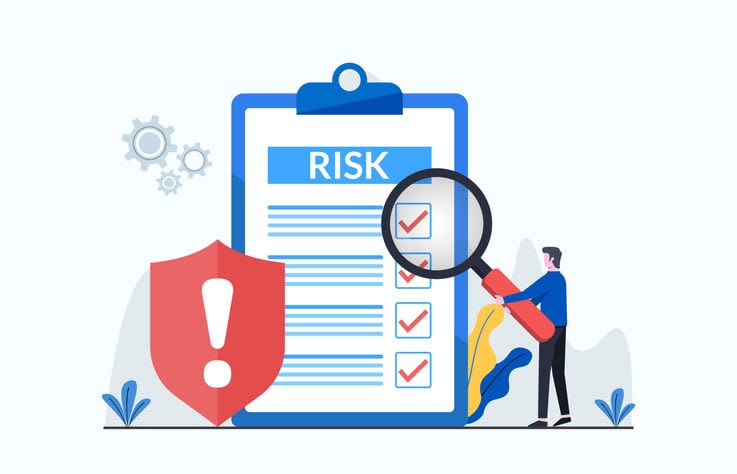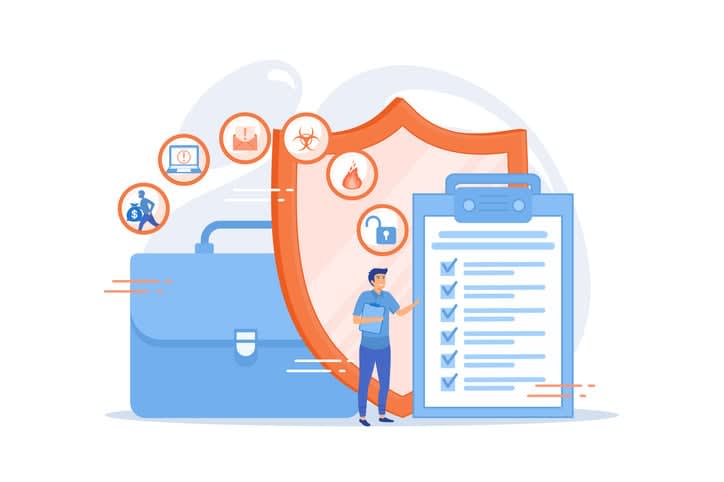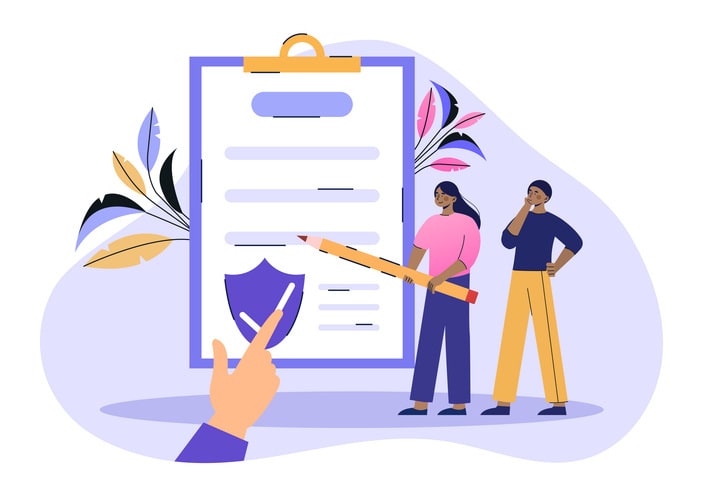Seeking to mitigate risk effectively? Your quest ends here. Discover five ways to buffer your business against the unexpected, starting now. Practical and concise, this guide goes beyond theory, providing actionable steps to fortify your strategy against threats. Here’s how you can take control and keep risks at bay.
Key Takeaways
- Risk mitigation is essential for business continuity, preventing risks from becoming issues, maintaining reputation, and satisfying stakeholders. It involves a broad spectrum of risks, including compliance, legal, strategic, reputational, operational, and financial, and requires regular assessments and strategic approaches tailored to each business’s unique environment.
- A robust risk mitigation plan encompasses risk identification, assessment, treatment, monitoring, and reporting. Based on the potential impact and probability of risks, businesses must employ various strategies, such as risk avoidance, reduction, and transference. Interdepartmental collaboration, the use of analytics, and management platforms are critical in crafting and executing these plans effectively.
- Technological advances, especially in analytics and AI, revolutionize risk management by providing real-time insights and automation. Also, fostering a culture of risk awareness, open communication, a dedicated risk mitigation team, and cross-departmental collaboration are vital for a holistic risk management strategy.
Understanding the essentials of risk mitigation

Risk mitigation supports the key mission goal of business continuity, the ability to continue operations against a background of chaos or trauma. At its core, risk mitigation focuses on reducing the levels of risk to an acceptable threshold for the business through various strategies tailored to the organization’s unique circumstances. The goal of risk mitigation is:
- To prevent risks from turning into problems
- To maintain a positive industry reputation
- To safeguard business operations
- To keep stakeholders happy.
The journey through the risk management and risk mitigation processes is not one-size-fits-all. It requires practical steps tailored to each business's unique industry, environment, and operational climate.
Risk mitigation has two benefits. On the one hand, it delivers tangible benefits like maintaining profitability. On the other, it offers intangible benefits such as upholding a positive industry reputation.
Even for modern remote businesses using Kumospace as their virtual office space, there are plenty of risks, due to a reliance on technology and distributed teams, spreading the risk of something going wrong in their region or country. On the plus side, a remote time is less likely to be impacted by a major event that strikes a traditional office based in one location.
The spectrum of business risks
Businesses encounter a complex web of risks that span across multiple domains, including:
- Compliance
- Legal
- Strategic
- Reputational
- Operational
- Financial
Strategic risks can alter a company’s competitive position and objectives, while operational risks can disrupt the efficiency of business activities. Reputational risks are tied to public perception, and financial risks are linked to cash flow, profitability, and solvency.
In today’s interconnected world, businesses also grapple with technology risks due to IT infrastructure challenges and the integration of new technologies. Failing to adhere to regulatory demands, such as those detailed in Sarbanes-Oxley and GDPR, can lead to significant penalties and operational risks. Hence, an organization’s approach to risk management must address these interconnected risks to protect their capital and adhere to regulatory requirements.
Crafting a robust risk mitigation plan

Before you even start your company, a business operating agreement is a key step in preventing political or commercial upheaval. Then, when it comes to risk mitigation, there’s no one-size-fits-all approach to business preparedness. A risk mitigation plan must be tailored to a business’s unique strategy and circumstances to be effective. The process begins with:
- Risk identification
- Assessment
- Treatment
- Monitoring
- Reporting
This plan offers controls to minimize risks while maintaining safety and operational continuity.
Risk mitigation is not an isolated task. It requires interdepartmental collaboration to tailor plans according to risks unique to different departments within a business. By addressing specific organizational risks proactively, businesses can prevent crises from drastically impacting their operations.
Conducting thorough risk assessments
Risk assessments act as the foundation of any robust risk mitigation plan, aiming to prevent any risk happening. They involve:
- Identifying hazards
- Determining potential harm
- Evaluating risks
- Documenting findings
- Consistently reviewing and updating to manage identified risks effectively
Your business should always be looking to act more efficiently, and as it evolves, new hazards emerge, so fresh risk assessments become crucial for maintaining the relevancy and effectiveness of the risk management strategy.
In today’s data-driven world, advanced data analytics and modeling tools offer a higher precision in risk quantification. They allow organizations to simulate various scenarios and make informed decisions based on comprehensive risk assessments. Prioritizing risks through early identification and understanding their potential impact is essential to focus mitigation efforts most efficiently and effectively, minimizing possible setbacks in project progress or strategic objectives.
Strategic implementation of mitigation strategies
Developing a strategic risk mitigation plan is crucial for ensuring that all critical elements, including risk acceptance, avoidance, transfer, and reduction strategies, are in sync with business objectives. Interdepartmental collaboration is essential for sharing knowledge and understanding risks more fully, leading to the creation of proactive mitigation strategies.
In the digital era, management platforms like ZenGRC support risk mitigation by:
- Assigning tasks
- Setting deadlines
- Permitting real-time progress tracking
- Facilitating the adaptation of strategies as required.
Ongoing risk monitoring and adjustment
Risk reporting becomes most effective when it’s integrated into a business's regular workflows, allowing for the continual application of risk controls and adjustments.
Automation in risk monitoring can offer the following benefits:
- Immediate alerts to risk owners and stakeholders, enabling prompt and appropriate response to changes
- Fostering risk awareness among various departments
- Maintaining stakeholder satisfaction
These benefits are critical for a comprehensive risk management approach, particularly for complex and extended projects.
Deciphering common risk mitigation strategies

When it comes to managing risks, there are several common strategies businesses can employ. These include:
- Risk avoidance
- Risk reduction
- Risk transference
- Risk acceptance
Strategies of risk avoidance and reduction are used in tandem to prevent potential risks and diminish their impact on business operations.
On the other hand, risk transference strategies involve shifting potential financial liabilities of risks to third parties, often employed when high-impact risks have low occurrence probabilities. Risk acceptance is chosen when a risk’s probability or negative impact is minor, or the costs of potential risk outcomes are less than the costs of mitigation.
The risk avoidance strategy
Risk avoidance is akin to nipping the problem in the bud. It involves identifying, assessing, and eliminating risks to prevent potential harm to an organization, its assets, or stakeholders, effectively removing the possibility of a risk occurring. This strategy is typically employed when a potential risk poses a substantial threat to the organization, or when the costs of mitigating the risk outweigh the potential benefits.
Examples of risk avoidance include electing not to engage in a risky investment or selecting established technology over new, less tested options as a way to avoid potential issues. However, it’s important to remember that avoidance may not always be the optimal path if a risk is unlikely to have a significant impact, due to the potential for high costs and the loss of opportunities that could benefit the organization.
Risk reduction tactics
Risk reduction is a key player in the game of risk mitigation. One of the most practical ways of reducing risk is by investing in regular and proper maintenance of equipment to decrease the likelihood of breakdowns. This minimizes the risk of equipment failure and associated repair costs, contributing to overall risk mitigation. Among the various types of risk mitigation, this approach is particularly effective in preventing potential issues.
While the knowledge base doesn’t provide specific facts about how reducing project scope can help in mitigating risks, it’s safe to infer that a reduced scope leads to fewer variables at play, which in turn can reduce the likelihood of unexpected setbacks or project risks.
Risk transference techniques
Risk transfer, also known as risk transference, shifts the burden of a potential risk from one party to another. This process involves allocating risk between different parties away from the company, typically by passing the consequences of specific risks to a third party. Many businesses transfer risk by paying insurance companies to cover certain risks, including keeping insurance coverage up to date with options like business interruption insurance to protect against financial losses.
Contracts with suppliers, outsourcing partners, or contractors can include provisions that transfer certain risks from a company to these third parties. This technique is a powerful tool for risk mitigation, especially in complex business scenarios involving multiple stakeholders.
Specialized approaches to specific risk types

With a myriad of risks lurking in the business landscape, a one-size-fits-all approach to risk management is not effective. Different types of risks require specialized approaches. These include financial risks, legal risks, and disaster-related risks, each with its own set of challenges and solutions.
For instance, financial risks related to financial transactions and partnerships significantly influence a company’s profitability and require thorough attention in risk management strategies. Meanwhile, legal risk involves the potential for encountering legal issues related to contracts and legal regulations. And when it comes to disaster-related risks, having robust business continuity plans and disaster recovery measures in place is essential.
Financial risk management
Effective financial risk management involves investing in strong internal controls and segregation of duties to reduce the financial risks related to errors and fraud. Proper cash management, through forecasting cash flows and monitoring receivables and payables, is integral to managing financial risks effectively.
Several strategies, like internal controls, cash management, and attention to the impact of financial transactions, consolidate the efforts to mitigate financial risks. Regularly evaluating business operations for efficiency can unlock cash flow to cover impacts of financial risks and help identify potential risks early.
Leveraging high-quality financial technology, like cloud-based accounting software and integrated ERP systems, can support financial risk management by helping to identify trends and analyze potential risks.
Legal risk preparedness
When it comes to legal risks, prevention is better than cure. To shield personal finances from legal claims, small businesses should establish a business entity that provides liability protection and secure insurance coverage tailored to the business’s needs. Avoidance of over-promising on products or services and establishing clear, fair policies are proactive ways to reduce legal risk.
Keeping thorough records and obtaining counsel from reputable lawyers on potential legal issues can minimize the occurrence of legal disputes. And when the storm hits, remembering to promptly contact their lawyers, gather all pertinent information, and remain composed while continuing business operations is essential.
Disaster readiness and response
The unpredictable nature of disasters makes them one of the most challenging risks to manage. Business continuity plans encompass:
- Evacuation procedures
- Shelter-in-place measures
- Emergency supplies
- Communication strategies for handling natural hazard emergencies.
To ensure effective disaster recovery, the following measures are necessary:
- Consistent data backups
- Off-site data storage
- Designation of an alternate operational location if the primary site is compromised
- Arrangements for backup utilities like portable generators to maintain operations during utility disruptions caused by natural disasters.
Implementing systems for two-way communication with employees is crucial for disaster management, allowing for coordination during and after the event.
Leveraging technology in risk mitigation

In the digital transformation era, technology has become a game-changer in risk management. By collecting, storing, and analyzing risk-related data, technology enables real-time risk reporting and valuable insights for decision-making.
From identifying and managing financial risks with financial technologies like cloud-based accounting software and integrated ERP systems, to addressing business impacts arising from cyber-attacks and data breaches with cybersecurity measures, technology plays a vital role in risk mitigation. The advent of AI has further enhanced business operations and risk management capabilities through advanced analysis and automation.
Empowering teams for effective risk management

In the realm of risk management, it’s not just about having the right strategies in place. It’s also about having the right people on board. Ensuring smooth operations and risk prioritization within an organization requires a thriving culture that recognizes the importance of:
- being aware of potential risks
- promoting open communication about risks
- encouraging proactive risk mitigation
- fostering a sense of responsibility for risk management
Creating an organizational culture that emphasizes open communication and trust allows team members to:
- Share insights and concerns regarding risks without fear of judgment
- Engage in regular communication about risks
- Be involved in risk management processes
This builds trust and alignment within the team.
Building a dedicated risk mitigation team
Modern companies necessitate the establishment of a dedicated risk mitigation team to comprehensively reduce the effects of certain risks. Having a designated person or team responsible for risk monitoring and reporting fosters focused and proactive risk management efforts.
Allocating explicit responsibility for risk management to individuals within the organization enhances ownership and the effectiveness of risk mitigation. A dedicated risk mitigation team must encapsulate diverse stakeholders from multiple departments to aggregate their intricate understanding of potential threats, which promotes a more holistic and effective risk assessment.
Above risk managers, leaders need to demonstrate how important risk is to the company, so that managers and workers will follow, preventing a slack approach to cyber, office and other risks.
Training and resources
Training and resources play a pivotal role in enhancing risk management skills among team members. Offering learning opportunities such as workshops, courses, and mentoring programs allows team members to learn from experts and apply best risk management practices.
Providing training and resources enhances collaboration skills among team members, such as active listening, constructive feedback, and conflict resolution, which are vital for effective risk management.
Collaboration across departments
In today’s interconnected business environment, collaboration across departments is key to effective risk management. Technology plays a crucial role in facilitating seamless collaboration and communication among stakeholders, ensuring transparency and timely response to risks.
Platforms like monday.com Work OS allow teams to collaborate effectively on risk identification and categorization through document sharing, annotation, and tagging colleagues.
Collaboration tools like Kumospace improve the effectiveness of communications, improving risk mitigation efforts across the organization, paving the way for a more integrated approach to risk management. And if a major event occurs, Kumospace will keep people in touch, help them solve problems and react to reduce the negative impacts while building a stronger team as a result.
Summary
Risk mitigation is more than just a business strategy; it’s an essential element in the survival and success of any organization. By understanding the essentials of risk mitigation, identifying the spectrum of business risks, crafting a robust risk mitigation plan, deciphering common risk mitigation strategies, adopting specialized approaches to specific risk types, leveraging technology, and empowering teams for effective risk management, businesses can navigate the rough seas of uncertainty and risk.
Remember, risk management is not a destination, but a journey. It requires continuous monitoring, adaptation, and improvement. With the right strategies, tools, and mindset, organizations can not only mitigate risks but also turn them into opportunities for growth and innovation.
Frequently Asked Questions
Risk mitigation is the process of reducing risk to an acceptable level for the business through tailored strategies.
Technology can enhance risk management by enabling real-time reporting and providing valuable insights for decision-making through the collection, storage, and analysis of risk-related data. Tools such as AI and cloud-based accounting software offer advanced analysis and automation capabilities for business operations and risk management. Apps like Kumospace help workers understand risks and manage events when they happen.
Having a dedicated risk mitigation team is important because it fosters focused and proactive risk management efforts, enhancing ownership and effectiveness. Including diverse stakeholders from multiple departments ensures a more holistic and effective risk assessment.
Training plays a crucial role in risk management by enhancing skills and knowledge among team members, allowing them to learn from experts and apply best practices (adapted from Answer 1).





